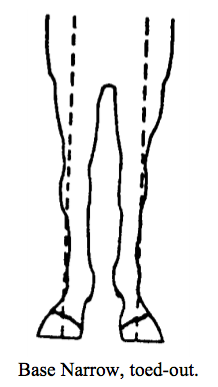Interfering
Horse and Rider | 2006
Q. Dear Mr. Smith,
I am having trouble finding a good corrective shoer. Several years ago I purchased a quarter horse. This is a wonderful trail horse, however, he interferes with his front feet. He will completely tear up a set of protective boots in a week of trail riding. Needless to say this is very expensive.
I have paid farriers extra money for special shoes but none of the shoes worked like the farrier said they would.
I would like to know what questions I should ask a farrier so that I know that he is experienced enough to fix my horse.
I would also like to know what kind of shoe the farrier should put on my horse so that he will stop interfering.
Thank you, Karen
A. Hello Karen,
You are stuck in a dilemma that is partly your making and partly farrier ego. The misconceptions surrounding what shoeing can do have been created by authors of articles who are not qualified to speak on the subject and by farriers whose training was insufficient, but whose egos are more than sufficient.
Front limb interfering is defined as; "A medial (inside) portion of a front foot strikes the medial side of the opposite front foot, leg or knee."
 Interfering is created by horses whose limbs are toed-out. In addition they
usually have some degree of base narrow. Stand your horse square and
measure the distance between the points of his shoulder (shoulder joints) and
then measure the distance between his center of his fetlock joint. If the
distance is more between the shoulders then your horse is base narrow.
Interfering is created by horses whose limbs are toed-out. In addition they
usually have some degree of base narrow. Stand your horse square and
measure the distance between the points of his shoulder (shoulder joints) and
then measure the distance between his center of his fetlock joint. If the
distance is more between the shoulders then your horse is base narrow.
Because of the bone alignment, the foot in flight must make an inward deviation (wing-in) prior to foot-fall. When the foot makes this inward deviation it can strike the inside of the opposing limb (interfering).
The simple truth is that the best way to prevent front limb interfering is to not purchase or breed horses that are base narrow and toed-out.
Far too often, horse owners overlook conformation defects in favor of personality, color or breeding for a specific discipline. When the conformation defect creates a problem owners are quick to hand over the responsibility of "fixing" the problem to the farrier. And farriers are just as quick to assume that responsibility and recommend a variety of shoes that they think will "solve" the problem.
When the farrier's shoes don't "fix" the problem horse owners naturally feel that the farrier is incompetent and begin the search for a farrier who is more knowledgeable. The farrier looses a client and a little bit of his reputation and the horse owner is frustrated with what they feel is a lack of quality farriers in the area.
Before I delve into shoeing it is very important that you understand that the responsibility for your horse's interfering belongs to the breeder and to the purchaser, not the farrier. You need to also understand that a base narrow, toed-out horse will interfere more often on uneven terrain and/or with an unsteady rider regardless of the shoeing.
Horse's feet will move toward traction and weight. The foot moves forward at about two and one-half times the speed of the horse. On the racetrack a horse will travel 30 miles an hour. This means that the foot is traveling 75 miles an hour. At this speed a few extra ounces of steel on the lateral (outside) branch of the shoe and some type of traction device will slow down the inward deviation of the foot in motion (interfering) and have a tendency to 'spread' the limbs. In addition the farrier may lower the medial side of the hoof during the trim. This is where the idea that farriers can "fix interfering comes from, racetrack shoeing.
However, a trail horse will be traveling at a speed of 3 or 4 miles per hour. His foot will only travel at 10 miles an hour, which means that weight and traction have very little, if any, effect on slowing down the inward deviation of the foot. Weight and traction are only effective as a means of 'spreading' the limbs of a horse when the horse is traveling at high speeds.
Lowering the medial side of the hoof during the trim will cause the fetlock to bear the horse's weight unevenly, creating fetlock problems in the future. Most racehorse owners do not care about fetlock problems in a ten-year old because the horse is no longer racing. But pleasure horse owners plan on keeping their horses for a long time.
My advice to you would be to find a farrier that is willing to work with you and try different shoes to see if any will work. You will need to understand that the farrier may end up putting several different types of shoes on your horse in the attempt to find something that may work. The shoes are usually hand made so they are more expensive, and that the end result may be that your horse will still interfere. You need to be prepared to pay for changes in shoes even though they may end up not being effective. And most importantly you need to understand that the problem has been created by a conformation defect and that a pair of horseshoes cannot change what Mother Nature has set in bone.